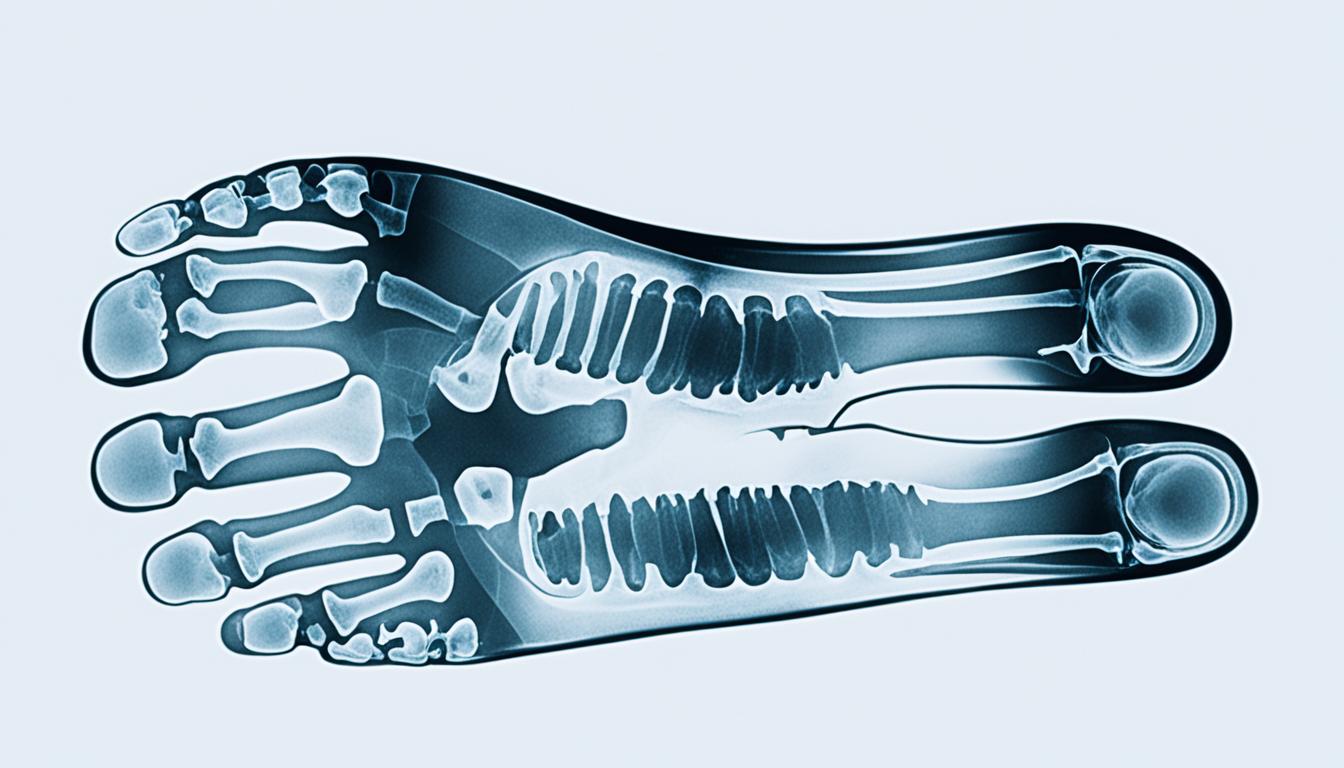A bone fracture is a break in a bone from sudden force or stress. It may cause pain, swelling, and bruising. People may find it hard to walk or move that part of the foot. Now, let’s talk about how these fractures happen and how doctors diagnose and treat them.
As you get older, the risk of these fractures goes up. This is especially true if you have a condition like osteoporosis. Doctors use exams and tests such as X-rays or MRIs to find fractures. Then, they work to ensure the bone heals well. Treatment might involve casts, braces, or surgery, depending on the break’s severity.
Key Takeaways:
- A bone fracture is a crack or break in a bone caused by high force impact or stress.
- Common symptoms of a foot fracture include pain, swelling, bruising, and difficulty in weight-bearing or moving the affected area.
- Aging and conditions like osteoporosis increase the risk of foot fractures.
- Diagnosis of foot fractures typically involves physical examination and imaging tests like X-rays, MRI, or CT scans.
- Treatment for foot fractures focuses on providing optimal healing conditions, including the use of casts, braces, or surgery.
Types of Foot Fractures and Their Causes
Foot fractures come in different forms, each with unique characteristics and causes. Knowing these helps doctors diagnose and treat them correctly. This can lead to better recovery for patients.
Avulsion Fracture
An avulsion fracture happens when a muscle or ligament pulls on a bone too hard. This force can break a piece of the bone off. Avulsion fractures are often seen in sports players. Movements like twisting or jumping can cause them.
Comminuted Fracture
A comminuted fracture is when a bone breaks into several pieces. It’s usually the result of a major accident, like a fall from a great height. Car accidents also often cause this type. Surgery is commonly needed to fix it by putting the pieces back together.
Stress Fracture
Stress fractures are tiny cracks in the bone from a lot of stress and strain. They are common in athletes or those who do a lot of high-impact activities. Too much running or bad training methods can cause stress fractures too.
Causes of Foot Fractures
There are many causes of foot fractures. They can be from big accidents, falls, or too much stress on the bones. Also, certain health issues that make the bones weak, like osteoporosis, can cause fractures.
As we get older, our bones can break more easily. This means we have to be more careful. It’s important to know what caused the fracture to treat it right. Getting the right treatment helps the foot heal well.
Treatment Options for Foot Fractures
Treating foot fractures depends on how bad they are. The first step is usually not surgery. Doctors use different ways to help heal and manage pain.
Non-Surgical Treatments for Foot Fractures
Non-surgical treatments focus on support and reducing pain. They include:
- Casts and Braces: These keep the foot still to help bones heal straight.
- Physical Therapy: It includes special exercises to make the foot stronger.
- Pain Management Techniques: Doctors may offer drugs to lessen pain and swelling.
Usually, these treatments work well. But if they don’t, surgery may be needed for severe fractures.
Surgical Options for Foot Fractures
If non-surgical ways don’t work, surgery might be needed. Operations change based on where and how bad the fracture is. Common surgeries are:
- Internal Fixation: It uses screws, plates, or nails to hold bones in place while they heal.
- External Fixation: Sometimes, devices outside the foot are used to keep it still and help it heal.
- Bone Grafting: This adds bone material to help regrow missing bone or heal bones that haven’t joined together.
Surgery can be very effective, especially for severe fractures.
Stem Cell Therapy for Foot Fractures
Stem cell therapy is innovative for foot fractures. It uses your own stem cells to heal the fracture without surgery.
In this treatment, stem cells are taken from your body and injected into the fracture site.
These cells can turn into different types of cells. They help heal your tissue, speed up recovery, and improve the results.
The good things about stem cell therapy are:
- It helps you heal faster.
- Your bones grow back better.
- It makes pain and swelling go down.
- Your life quality gets better.
Stem cell therapy changes how we treat foot fractures. It’s a simpler, non-surgical option.
It’s important to talk to an orthopedic doctor to pick the best treatment for you.
Conclusion
Foot fractures can really change how you go about your day. They bring pain and make moving around hard. It’s key to know about the kinds, reasons, and how to treat foot fractures to get better.
Casts and surgeries have long been useful for fixing foot fractures. But now, stem cell therapy is becoming a hopeful new path. It doesn’t involve surgery and uses the body’s natural healing, quickening recovery and boosting life quality.
If you have a foot fracture, it’s a must to talk to a qualified orthopedic surgeon. They will guide you to the treatment that best fits your situation. Looking at all your options could help you move better, feel less pain, and get back to an active life.

